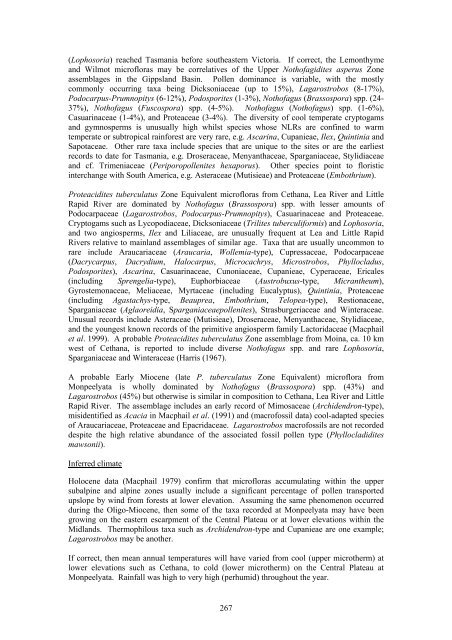OFR 151.pdf - CRC LEME
OFR 151.pdf - CRC LEME
OFR 151.pdf - CRC LEME
You also want an ePaper? Increase the reach of your titles
YUMPU automatically turns print PDFs into web optimized ePapers that Google loves.
(Lophosoria) reached Tasmania before southeastern Victoria. If correct, the Lemonthyme<br />
and Wilmot microfloras may be correlatives of the Upper Nothofagidites asperus Zone<br />
assemblages in the Gippsland Basin. Pollen dominance is variable, with the mostly<br />
commonly occurring taxa being Dicksoniaceae (up to 15%), Lagarostrobos (8-17%),<br />
Podocarpus-Prumnopitys (6-12%), Podosporites (1-3%), Nothofagus (Brassospora) spp. (24-<br />
37%), Nothofagus (Fuscospora) spp. (4-5%). Nothofagus (Nothofagus) spp. (1-6%),<br />
Casuarinaceae (1-4%), and Proteaceae (3-4%). The diversity of cool temperate cryptogams<br />
and gymnosperms is unusually high whilst species whose NLRs are confined to warm<br />
temperate or subtropical rainforest are very rare, e.g. Ascarina, Cupanieae, Ilex, Quintinia and<br />
Sapotaceae. Other rare taxa include species that are unique to the sites or are the earliest<br />
records to date for Tasmania, e.g. Droseraceae, Menyanthaceae, Sparganiaceae, Stylidiaceae<br />
and cf. Trimeniaceae (Periporopollenites hexaporus). Other species point to floristic<br />
interchange with South America, e.g. Asteraceae (Mutisieae) and Proteaceae (Embothrium).<br />
Proteacidites tuberculatus Zone Equivalent microfloras from Cethana, Lea River and Little<br />
Rapid River are dominated by Nothofagus (Brassospora) spp. with lesser amounts of<br />
Podocarpaceae (Lagarostrobos, Podocarpus-Prumnopitys), Casuarinaceae and Proteaceae.<br />
Cryptogams such as Lycopodiaceae, Dicksoniaceae (Trilites tuberculiformis) and Lophosoria,<br />
and two angiosperms, Ilex and Liliaceae, are unusually frequent at Lea and Little Rapid<br />
Rivers relative to mainland assemblages of similar age. Taxa that are usually uncommon to<br />
rare include Araucariaceae (Araucaria, Wollemia-type), Cupressaceae, Podocarpaceae<br />
(Dacrycarpus, Dacrydium, Halocarpus, Microcachrys, Microstrobos, Phyllocladus,<br />
Podosporites), Ascarina, Casuarinaceae, Cunoniaceae, Cupanieae, Cyperaceae, Ericales<br />
(including Sprengelia-type), Euphorbiaceae (Austrobuxus-type, Micrantheum),<br />
Gyrostemonaceae, Meliaceae, Myrtaceae (including Eucalyptus), Quintinia, Proteaceae<br />
(including Agastachys-type, Beauprea, Embothrium, Telopea-type), Restionaceae,<br />
Sparganiaceae (Aglaoreidia, Sparganiaceaepollenites), Strasburgeriaceae and Winteraceae.<br />
Unusual records include Asteraceae (Mutisieae), Droseraceae, Menyanthaceae, Stylidiaceae,<br />
and the youngest known records of the primitive angiosperm family Lactoridaceae (Macphail<br />
et al. 1999). A probable Proteacidites tuberculatus Zone assemblage from Moina, ca. 10 km<br />
west of Cethana, is reported to include diverse Nothofagus spp. and rare Lophosoria,<br />
Sparganiaceae and Winteraceae (Harris (1967).<br />
A probable Early Miocene (late P. tuberculatus Zone Equivalent) microflora from<br />
Monpeelyata is wholly dominated by Nothofagus (Brassospora) spp. (43%) and<br />
Lagarostrobos (45%) but otherwise is similar in composition to Cethana, Lea River and Little<br />
Rapid River. The assemblage includes an early record of Mimosaceae (Archidendron-type),<br />
misidentified as Acacia in Macphail et al. (1991) and (macrofossil data) cool-adapted species<br />
of Araucariaceae, Proteaceae and Epacridaceae. Lagarostrobos macrofossils are not recorded<br />
despite the high relative abundance of the associated fossil pollen type (Phyllocladidites<br />
mawsonii).<br />
Inferred climate<br />
Holocene data (Macphail 1979) confirm that microfloras accumulating within the upper<br />
subalpine and alpine zones usually include a significant percentage of pollen transported<br />
upslope by wind from forests at lower elevation. Assuming the same phenomenon occurred<br />
during the Oligo-Miocene, then some of the taxa recorded at Monpeelyata may have been<br />
growing on the eastern escarpment of the Central Plateau or at lower elevations within the<br />
Midlands. Thermophilous taxa such as Archidendron-type and Cupanieae are one example;<br />
Lagarostrobos may be another.<br />
If correct, then mean annual temperatures will have varied from cool (upper microtherm) at<br />
lower elevations such as Cethana, to cold (lower microtherm) on the Central Plateau at<br />
Monpeelyata. Rainfall was high to very high (perhumid) throughout the year.<br />
267

















